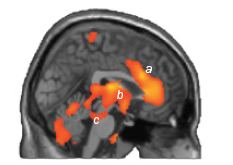Kock points in Scientific American Mind to work byLångsjö et al. (open access), who image the neural core of consciousness. They performed MRI imaging of patients recovering from propofol, dexmedetomidine, or sevoflurane anesthesia. Here is their abstract, followed by a key figure from the paper:
One of the greatest challenges of modern neuroscience is to discover the neural mechanisms of consciousness and to explain how they produce the conscious state. We sought the underlying neural substrate of human consciousness by manipulating the level of consciousness in volunteers with anesthetic agents and visualizing the resultant changes in brain activity using regional cerebral blood flow imaging with positron emission tomography. Study design and methodology were chosen to dissociate the state-related changes in consciousness from the effects of the anesthetic drugs. We found the emergence of consciousness, as assessed with a motor response to a spoken command, to be associated with the activation of a core network involving subcortical and limbic regions that become functionally coupled with parts of frontal and inferior parietal cortices upon awakening from unconsciousness. The neural core of consciousness thus involves forebrain arousal acting to link motor intentions originating in posterior sensory integration regions with motor action control arising in more anterior brain regions. These findings reveal the clearest picture yet of the minimal neural correlates required for a conscious state to emerge.

Colored areas indicate the parts of the brain that first come online when patients emerge from consciousness after being anesthetized with one of two different agents. The three critical regions are the anterior cingulate cortex (a), the thalamus (b) and parts of the brain stem (c).

